Cultural and Social Club
In the March 1975 edition of Barnard Alumnae, Leet recalled the vibrant intellectual ambiance that permeated Reid Hall during her leadership from 1947 – 1964:
[Thanks to the monthly diners hosted by the Pen Club] We had the pleasure, then, of chatting in this garden with Paul Valery, Jules Romains, Andre Maurois, François Mauriac, Hemingway, Scott Fitzgerald, Galsworthy, Pirandello, Sylvia Beach, Adrienne Monnier and so many others. Occasionally, André Gide came to sit quietly in this garden, for he had been a student at the Keller School here in about 1890.
I see in our salon the great statesmen like cabinet minister Louis Joxe, French ambassador Henri Bonnet, André Siegfried, Paul Hazard, Etienne Gilson, Antoine Bourdelle, Henri Focillon, Senator Honnorat, Abbé Dimnet, Paul Claudel, all the rectors of the University of Paris since 1924 and all the American ambassadors since Myron Herrick, Sir Gilbert Murray, Caroline Spurgeon and Lady Rhondda.
Mme. Curie sometimes came to lunch with me and Dr. Ellen Gleditsch of Norway. Mrs. Whitelaw Reid, Virginia Gildersleeve and Mme. Octave Monod guided my first steps, helped by Mmes. Cazamian and Puech and by Mr. Siegfried on international matters.
After the war, General and Mrs. George Marshall were our first guests at a garden reception, and Mme. Pandit of India came to dine here with 25 of our members, right after the war, in order to hear [...] ideas about France. I see in the Grande Salle the concerts of Nadia Boulanger and then, at our Thanksgiving dinners, Mrs. Eleanor Roosevelt and Gertrude Stein, and then a luncheon for the Count of Paris and other historians. And as speakers: Raymond Aron, René Huyghe, Jean Vilar, Judge Learned Hand, Abbé Breuil, Janet Flanner, Claude Nollier reading Claudel’s ‘Joan of Arc’. . . (Leet, cited in Percival 12).
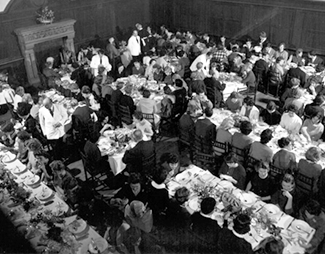
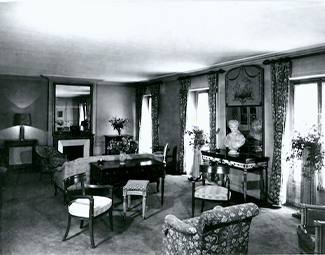
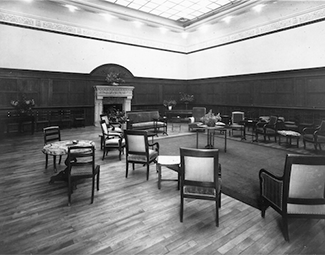
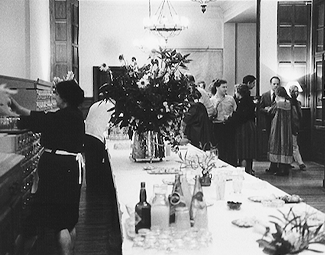
Thanks to Leet's indefatigable energy and her commitment to intercultural dialogue, the intellectual and artistic culture of Reid Hall remained quite substantial throughout the 1950s and early 1960s. In recognition of her "kind and wise regard and for giving so many friends to France," Leet, who had been knighted by the French Legion of Honor in 1934, was made Officer on November 15, 1949. Over three hundred people, including the new American ambassador to France, K.E. Bruce, attended the ceremony led by Louis Joxe, Conseiller d’État (New York Herald Tribune, Paris, November 16, 1949, n.p.).
Promoting French-American relations and educational exchange remained at the heart of Reid Hall’s activities. Reports by Dorothy Leet and Virginia Gildersleeve, meeting minutes, correspondence, and newspaper articles all signify Reid Hall as a vibrant center for French-American exchanges.
Leet was especially eager to foster connections between university women, believing that world peace could only be maintained through cross-cultural relations and understanding. Reid Hall thus remained the meeting place for the International Federation of University Women (IFUW) and the headquarters of the French Federation of University Women (AFDU). These groups were especially active in welcoming women to Paris for international congresses, and they frequently held meetings in the Reid Hall salons or gave lectures to residents and students. One of the most significant international events was the 12th Congress of the International Federation of University Women, held in Paris in August 1956. A dinner was hosted on August 2 by Reid Hall's Board of Directors for 100 officers and delegates. A cocktail party at the closing of the Congress attracted 1,000 guests in Reid Hall's gardens and salons. Virginia Gildersleeve's portrait was unveiled at the dinner, and was displayed in the Reid Hall library for many years (Leet's letter to members, November 1, 1956). Today, the portrait by Harold Matthew Brett is part of Reid Hall's art collection; an exact copy can be found in Columbia University's Art Properties collection in New York.
Groups of university women attending international congresses in Paris also used Reid Hall as a meeting place and for special sessions, most notably the Association of Librarians and the Association on Questions of Nutrition and Health (Report to Members, November 1, 1957). Individual women scholars in a variety of disciplines from Latin America, Asia, Israel, the Middle East, and Africa were invited to reside or speak at Reid Hall. Leet also encouraged American women students to interact with the Hall’s international residents in order to expose them to different cultures and thought patterns. She organized concerts, exhibitions, conferences, and other events through which Americans could meet their French and international counterparts, or come into contact with French academics and cultural organizations. The goal was to nudge Americans out of their bubble by placing them in "au-pair" situations that would allow them to be fully immersed in the French way of life. For example, clubs such as "Les 4 Vents" organized by the group “L’Accueil Familial des Jeunes Étrangers” enabled foreign students to interact with French families and offered courses at the Sorbonne in French civilization.
The American University Union was also headquartered at Reid Hall. This organization, which had long assisted American students in Paris at 173 bd. St. Germain, had also closed its doors during WWII. Headed by Charles B. Vibbert, professor emeritus of philosophy at Michigan University, and backed by funds from the Carnegie Corporation, the organization advised independent American students who integrated the French university system. They assisted students in planning their curricula, securing lodgings, and meeting French people. According to the New York Herald, Paris, in 1947, approximately 500 American students were in Paris (September 2, 1947, n.p.).
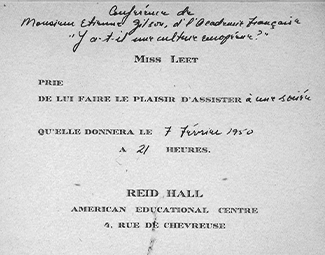
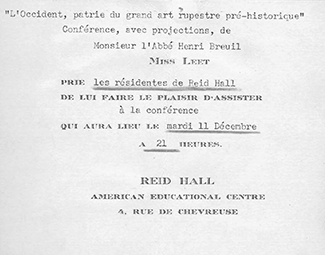
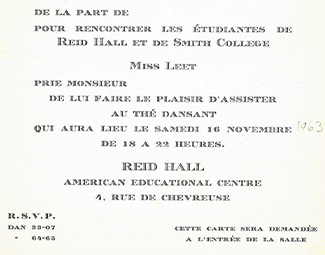
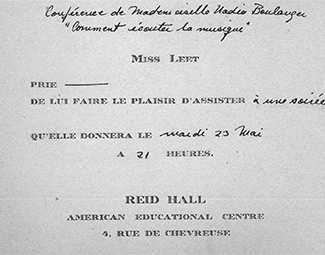
Reid Hall thus became an international hub for lectures, monthly teas with guest speakers, luncheons, and receptions in honor of members of the Board, notable visitors, or important French and American officials. Guest speakers at teas or dinners held court on international politics, socioeconomic tendencies, artistic trends, and literary tastes. Beginning in 1951, their presence was made possible through the Caroline McCormick Slade Memorial Fund (Slade was a former Trustee of Bryn Mawr College and member of the Reid Hall Board of Directors). Regulars amongst the speakers were:
- Raymond Aron, philosopher, journalist and professor at the École nationale d’administration (ENA) and the Sorbonne, spoke about politics in France (1951, 1953, 1954, 1955, 1956, 1957, 1958, 1959, 1961).
- French composer Nadia Boulanger had already been at Reid Hall in 1927 and 1937; after WWII, she was invited to speak about music and perform piano demonstrations, sometimes accompanying students who had won the music scholarships (1950, 1951, 1952, 1954, 1955, 1956, 1957, 1958, 1959, 1960, 1961, 1962, 1963 concert in memory of President John F. Kennedy).
- Abbé Henri Breuil, noted prehistorian and collaborator of former Reid Hall resident Mary Boyle, spoke on parietal art in France (1955, 1956)
- Abbé Ernest Dimnet, Catholic priest, writer, teacher, and Montparnasse neighbor, who already had been a guest speaker in the 1930s, attended teas and other functions at Reid Hall until his death in 1954.
- Janet Flanner, celebrated columnist for the New Yorker and longtime friend of Leet's, Flanner spoke at Reid Hall in 1951, 1953, 1955, and 1957, sharing her perspectives on "France Today."
- Etienne Gilson, historian, philosopher, at the Collège de France, and “Académicien,” (1947, 1949, 1950).
- René Huyghes, philosopher at Collège de France and “Académicien,” spoke on French painters (1952, 1953, 1954, 1955, 1958, 1959, 1960, 1962, 1963).
- French actress Claude Nollier of the Comédie française (1954, 1955, 1956, 1957, 1959, 1960, 1961, 1962, 1963, 1964).
- American broadcast journalist David Schoenbrun (1952, 1956, 1960, 1961).
- Political writer and “Académicien” André Siegfried spoke about his visits to the U.S. (1947, 1948, 1949, 1952, 1953, 1954, 1956).
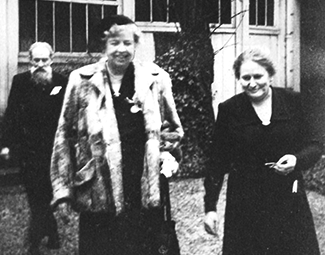
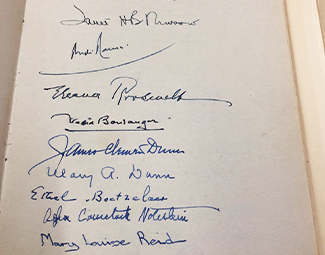
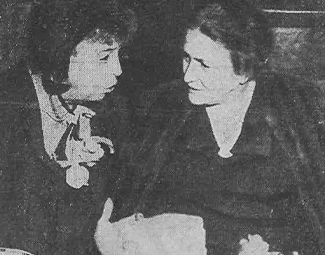
Reid Hall’s annual Thanksgiving dinner was also an opportunity to invite esteemed speakers and host special guests. Former First Lady Eleanor Roosevelt attended on November 22, 1951, while she was in Paris as an American delegate to the United Nations. Another guest of honor was Dr. Mildred McAfee Horton, former President of Wellesley College, who served as a member of the U.S. delegation to the UNESCO assembly in Paris that year.
A Christmas dinner was also held every year on December 25th without any speakers, but with musical entertainment and dancing. Toward the late 1950s, this celebration was preceded in the week by a festive "Christmas eggnog."
A particularly celebrated annual event at Reid Hall was the "thé-dansant," a soirée meant to introduce the women of Reid Hall to students from various Parisian institutions, notably Polytechnique, Sciences Po, ESSEC, HEC. Valéry Giscard d'Estaing, who would later serve as France’s president between 1974 and 1981, attended an officers' ball at Reid Hall in the 1950s. He still recalled that festive occasion when he returned to Reid Hall in 2016 to discuss French politics and his presidency.
In keeping with the turn-of-the-century traditions of the Girls’ Art Club, Leet also organized art exhibitions featuring work by students. In 1950 – 1951, the art students in the various study groups at Reid Hall installed a painting and sculpture show, with prizes awarded by French and American art critics. In 1952, there were 13 exhibitors: Shirley Kaplan; Jane Wolverton; Carole Cleworth; Gertrude Bookbinder (student of the sculptor Ossip Zadkine); Anna Blakemore (student of painter André Lhote); Margaret Gatch (Smith College); Lucy Keith (Smith); Anita Slowcome (Smith); Carolyn Hill; Ellen Howard; Josephine Matsen (Smith); Barae Lamb (Smith); and Prof. Beatrice Hyslop showed color photos. The exhibition was reviewed in Actualité artistique et internationale (March 27, 1952, n.p.) and several young women were singled out as showing great promise: Kaplan, Wolverton, Blakemore, and Bookbinder. On May 31, 1953, exhibitors included: Margaret Abe; Margot Avery; Barbara Cledon; Barbara Hicks; Grace L. Hoffman; Nell MacCracken; June Nakamura; Lorna Muir Himmo; Jeanne Sigg; Caroline Hill. Shirley Kaplan, who studied at Académie de la Grande Chaumière and remained in Paris for four years, seems to be the only student who later pursued a career as an artist.
In June 1952, Reid Hall marked two special anniversaries: 30 years as a Paris residential center for students, and 60 years since its official founding as the Girls’ Art Club, the first iteration of this beloved Franco-American center. According to Leet's report to the Board:
Ambassadors Dunn and Joxe spoke with warm appreciation of the work accomplished in international understanding. Ogden Rogers Reid cut the birthday cake, and it was a special pleasure to have with us our board members [...] as well as numerous French and American friends [...] (October 30, 1952, BC Archives).
The 35th anniversary celebration in June 1957 was also a great success, attracting Ambassadors Houghton and Bonnet and as many as 250 guests. On this occasion, residents gave Reid Hall a Daum vase, which no longer exists on the property (Leet letter to Reid, June 25, 1957).
The 40th anniversary event held in 1962 attracted 350 distinguished guests, including the American ambassador, members of the Ministry of Foreign Affairs, the French director of cultural relations, the rector of the University of Paris, the director of the Institut d’études politiques, representatives from the U.S. Educational Commission for France, professors, and, of course, Reid Hall’s residents (Leet Letter to Reid, March 24, 1962).